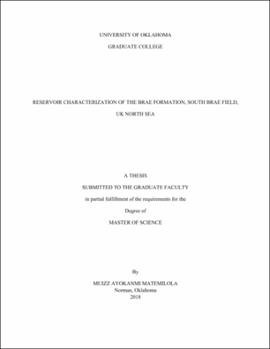| dc.description.abstract | The South Brae Field is located 166 miles off the coast of Aberdeen, Scotland in the UK sector of the North Sea. The Upper Jurassic Brae submarine channel-fan complex deposits are the primary hydrocarbon reservoirs in UK Blocks 16/07a and 16/07b. The field is composed of channelized silici-clastic slope-apron and fan deposits from high- to low-density debris flows, sandy and muddy turbidites, and hemipelagic settling. They were deposited during the Late Oxfordian to Middle Volgian. The Kimmeridge Clay Formation is a regionally-extensive, organic-rich, transgressive shale—deposited concurrently—that separates the Brae Formation from the overlying Cretaceous deposits and serves as the source rock and stratigraphic seal. The reservoir is trapped by the western escarpment of the South Viking Graben, which formed as a result of Permo-Triassic rifting and additional Middle to Late Jurassic rifting events.
The Brae formation is composed of seven main lithofacies including conglomerate, pebbly sandstone, sandstone, sandy siltstone, silty shale, shale, and calcite-cemented sandstone. Core descriptions, thin-section petrography, x-ray diffraction, and core plug measurements were used to understand the lithological, depositional, and petrophysical variations of the formation. Log-based, and seismic stratigraphic correlations were used to identify second-, third-, and fourth-order stratigraphic sequences. Thickness maps of the subunits within the Early to Middle Volgian – J66 – third-order sequence and spectral decomposition of the seismic volume aided the identification of depositional fairways within the upper part of the Brae Formation.
Electrofacies were generates using supervised multi-variate cluster analysis and artificial neural network classification models. The classifications showed overall accuracies around 90 percent. Facies proportion maps were constructed to understand their lateral distribution within the third-order sequence. Log-based and seismic stratigraphic interpretations of fourth-order sequences within the J66 sequence helped to illustrate the internal distribution of the reservoir-quality facies (sandstones, pebbly sandstones, and conglomerates) within the depositional fairways. The lower subunit of the J66 system – the Ac subunit – is composed of laterally- and vertically-connected channel-fills and fans with a high abundance of thick calcite-cemented sandstone concretions that impede the flow of fluids within the reservoir. The Aa subunit – the upper part of the J66 sequence – primarily contains isolated channel-fills with a smaller amount of calcite concretions. Both subunits are composed of sandstone, pebbly sandstone, and conglomerate channel-fans and fans that were deposited after incision into muddy turbidite units that underlie them. | en_US |
